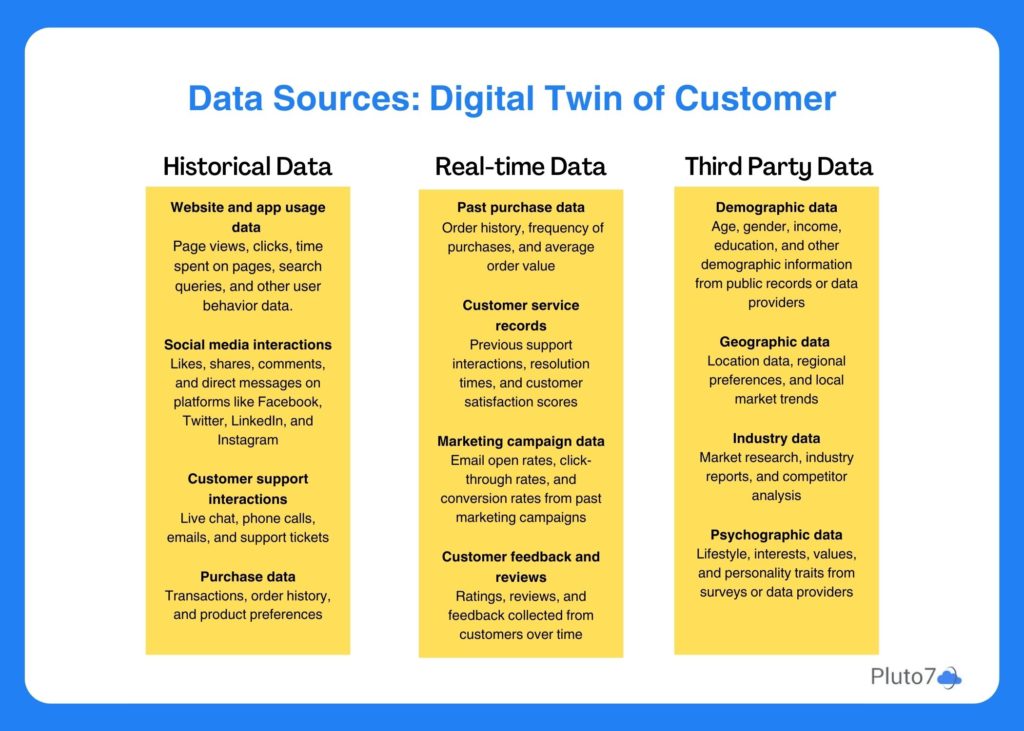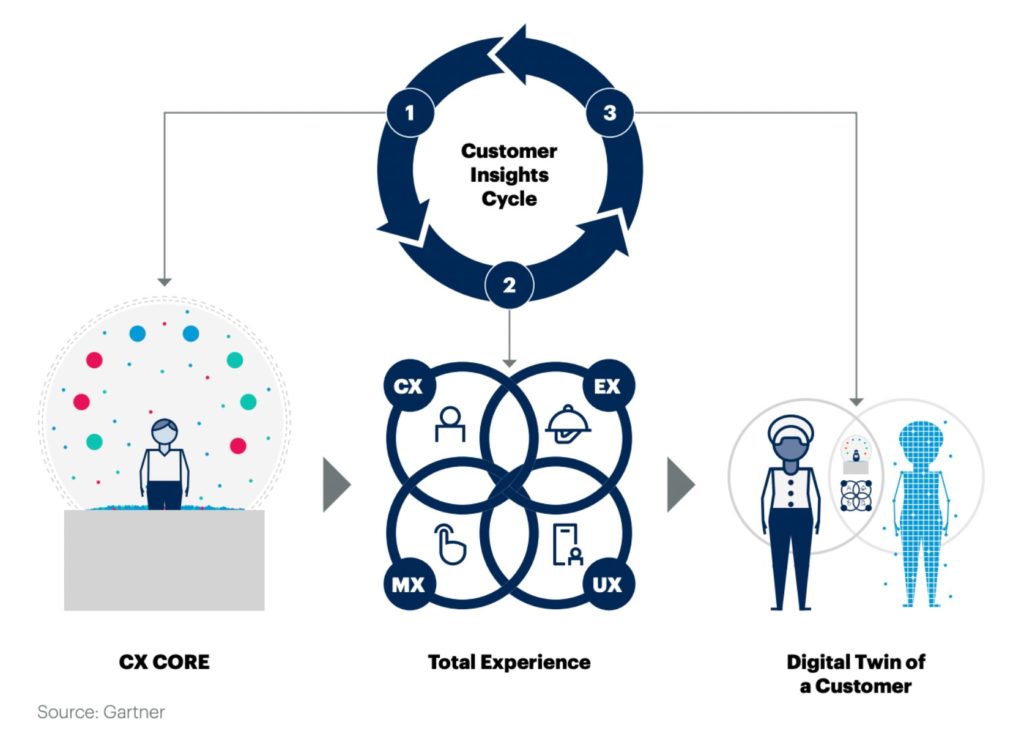
Transform Your Supply Chain Planning and Marketing Strategies with Google Cloud and SAP Integration

Transform Your Supply Chain Planning and Marketing Strategies with Google Cloud and SAP Integration
July 21, 2023 | Megha Aggarwal
Blog / Digital Twin of the Customer: Supply Chain Leader’s Key to Understanding Customer Behavior
Companies that prioritize customer experience achieve 4-8% higher revenue compared to their industry peers.
Understanding and predicting customer behavior is a common challenge across industries, including supply chain. Modern customers expect exceptional experience. Their experience starts long before a purchase is made – online or offline. It starts with your supply chain.
Digital twin of Customer is a powerful way to give your customers the experience they want.
By creating virtual replicas of individual customers, known as the digital twin of the customer (DToC), supply chain leaders can gain unprecedented insights into customer preferences, needs, and behaviors.
Pluto7’s Google Cloud Cortex aligned, prepackaged solutions connect your data end-to-end and serve as the perfect foundation to build digital twins. Endorsed back-to-back by Gartner in their “Market Guide for Analytics and Decision Intelligence Platforms in Supply Chain,” our decision intelligence platform “Planning in a Box” seamlessly enhances the capabilities of the Digital Twin enabling informed decision-making and optimizing supply chain operations.
Let’s explore how supply chain leaders can leverage this innovative solution to unlock valuable customer insights, enhance personalization efforts, and make data-driven decisions that lead to business growth.

The Digital Twin of the Customer (DToC) offers a flexible and adaptable approach to anticipating customer behavior, particularly in uncertain times when traditional historical data may not provide accurate predictions.
Unlike static models, the DToC leverages a probabilistic and iterative framework that embraces the dynamic nature of customer behavior. This makes it a valuable tool for supply chain leaders seeking to navigate through unpredictable market conditions and make informed decisions based on real-time insights from the customer’s digital twin.
Leading CSCOs must invest in building Digital Twin of Customers to overcome the challenges in accurately forecasting consumer expectations for new products or services, and improve overall sales effectiveness.
Empower Your Supply Chain with Digital Twin
Make data-driven decisions. Improve your operational efficiency
Digital Twin of Supply Chain (DTDC) has been around for a while. It has been adapted by many companies for end-to-end visibility, accurate demand forecasting, optimized inventory management, improved operational efficiency, and agile decision-making.
DToC, though an extension of DTSC, differs in the way it benefits its users. While DTSC focuses on supply chain analytics and inventory positioning, DToC focuses on marketing analytics and demand sensing.
| Digital Twin of Supply Chain (DTSC) | Digital Twin of Customer (DToC) |
|---|---|
|
The purpose of DTSC is to improve the performance of the supply chain |
The purpose of DToC is to improve customer experience |
|
DTSC takes data from suppliers, manufacturing, transportation, logistics, real-time data, external data sets |
DToC takes data from customer purchase history, social media activity, website behavior, customer support interaction, marketing campaign data, demographic, geographical, psychographic data |
|
|
|
Solution: Pluto7’s Data Platform with Demand ML |
Solution: Pluto7’s Planning in a Box and Marketing ML |
Watch Video: Minimizing Manufacturing Disruptions with Digital Twin
Data: Data is the core of any digital twin. DToc data comes from a variety of sources. It takes 3 types of Data – Historical, Real-time, and third party data. Pluto7’s Planning in a Box data platform leverages Google Cloud Cortex, an advanced data model to provide robust support for the creation and utilization of a digital twin of the customer.

Algorithms: Advanced ML algorithms are used to analyze the data and to create a virtual representation of the customer. These algorithms analyze and segment customer data, learn patterns, and predict customer behavior.
Interface: The interface is needed to interact with the Digital Twin of Customer. Users can access the virtual representation of customers through the interface, and delve into their unique characteristics, behaviors, and preferences. Through this, businesses can forge a deeper understanding of their customers and deliver tailored experiences that resonate with them.
Know Your Customers Like Never Before
Create Hyper personalized experiences with Marketing ML
DToC works on two core concepts (as defined by Gartner):
CX (Customer Experience) CORE: It creates a persona for an individual or a group that keeps providing insights into the right TX for the persona.
TX (Total Experience): It maps out a superior shared experience for customers moving them to a better relationship stage.

The digital twin and its physical representation are constantly connected, staying in sync through real-time actions and events. This connection allows the digital twin to continuously gather data, which is then fed into the CX (customer experience) model.
The CX model takes this data and feeds it into the TX (total experience) strategy, enhancing the customer experience even further. It’s an iterative process where the digital twin learns from real-world actions, improves the CX, and contributes to the creation of superior customer experiences through the TX strategy.
This continuous cycle of data collection and refinement drives the evolution of the customer experience towards excellence.
66% of the consumers expect companies to understand their needs and expectations (source).
To thrive in today’s competitive landscape, CSCOs must prioritize customer-centric strategies and leverage innovative technologies to deliver personalized experiences and build lasting customer relationships.
Pluto7’s Google Cloud Cortex enabled Planning in a Box platform harnesses the potential of big data and enables you to capture, integrate, and analyze customer-centric data from various touchpoints. It seamlessly consolidates real-time, historical, and third-party data to create a comprehensive view of each customer.
It lays the essential groundwork for building digital twins by connecting your data end-to-end.
With Marketing ML and Sales ML solutions on top of this foundation, you can leverage customer insights to predict behaviors, anticipate preferences, simulate customer interactions, and set pricing strategies.
Here’s how supply chain leaders can use DToC to solve their business challenges:
In today’s volatile market, demand sensing is becoming increasingly important as companies face a variety of challenges that make traditional demand planning less effective.
The DToC takes a customer-centric approach to demand sensing by creating a virtual replica of each customer’s characteristics, preferences, and behaviors. By integrating data from various touch points in customer journey, the DToC captures a holistic view of each customer’s journey.
With the DToC, supply chain leaders can uncover patterns, trends, and correlations in customer behavior that traditional methods might overlook. This granular understanding enables more accurate and precise demand sensing at an individual customer level, and helps shape the demand with customized recommendations, tailored campaigns, personalized experiences.
Read Case Study: A leading American departmental retail chain improved their forecast accuracy to 85%
Optimized supply chains incur 15% lower supply chain costs.
Supply chains today are under the spotlight. They have moved from back office to front office. They need to be agile, responsive, and quickly respond to changing customer demand.
Digital Twin of Customer helps CSCOs gain a clear insight into customer’s changing needs, likes, and dislikes. They can use this information to optimize demand forecasting, align production and inventory levels, and implement just-in-time inventory strategies.
Real-time visibility into customer demand trends enables proactive inventory planning and reduces the risk of stockouts or excess inventory. Additionally, the DToC helps identify inefficiencies and bottlenecks in the supply chain, allowing leaders to make data-driven decisions for process improvement and operational efficiency.
Watch Video: AB InBev, world’s oldest and most popular beer brand solved their supply chain issues with Pluto7
The DToC provides valuable insights into customer preferences related to delivery options, packaging, and timing. Businesses can utilize this data to personalize the order fulfillment process by offering tailored options such as same-day delivery, preferred carriers, and eco-friendly packaging.
Moreover, leveraging DToC insights allows businesses to proactively address potential issues during fulfillment, thereby enhancing customer satisfaction and minimizing the chances of negative experiences. For instance, if a customer has previously reported packaging damage, businesses can take preventive measures to ensure secure packaging, avoiding similar problems in the future.
Additionally, the DToC serves as a valuable source of feedback from customers regarding the fulfillment process. By actively monitoring customer feedback and preferences, businesses can identify areas for improvement and continuously optimize their fulfillment operations.
The Digital Twin of Customer (DToC) is not only a powerful tool for enhancing customer experiences but also for enabling sustainability tracking within your business. By leveraging the DToC, you can promote eco-friendly practices and measure the impact of your sustainability initiatives transparently.
With Digital Twin of Customers, align your business with sustainability goals, engage customers in eco-conscious choices, and contribute to a more sustainable future.
The Digital Twin of Customer empowers supply chain leaders to achieve decision optimality by harnessing customer-centric insights, personalizing offerings, analyzing real-time data, forecasting demand, and enabling continuous improvement.
CSCOs can gain valuable insights into customer needs, desires, and buying patterns with the DToC data. These insights can be used to tailor supply chain decisions to meet customer expectations, resulting in improved customer satisfaction and loyalty.
Read Case Study: Tacori, a leading jewelry design house in California served their customers better by gaining critical behavioral insights
Businesses can optimize decision-making around product development, pricing strategies, and marketing campaigns, ensuring maximum relevance and resonance with customers.
As a leader in AI/ML and Generative AI, Pluto7 is well equipped to help you win, retain, delight your customers with exceptional customer experience with the implementation of Digital Twin.
Implementing the Digital Twin of the Customer (DToC) in the supply chain comes with its share of challenges and barriers. Common hurdles that organizations may face:
| Challenges in implementing DToC | Solve it with Pluto7’s Google Cloud Cortex enabled Data Platform |
|---|---|
|
Data Integration: Needs data from multiple systems, touchpoints, and departments within the organization. Ensuring data accuracy, reliability, and consistency can be a complex and time-consuming process. |
Facilitates smooth integration between SAP, non-SAP systems, Salesforce, Google AdTech with reduced risk and complexity. |
|
Data Quality: Inaccurate or incomplete data can lead to flawed insights and hinder the effectiveness of the digital twin. |
Automates quality checks, data cleansing, data validation ensuring high-quality data. |
|
Data Privacy and Security: Risk of exploiting sensitive customer information. |
Ensures strict data protection regulations and appropriate measures to safeguard customer information. |
|
Organizational Alignment: Requires cross-functional collaboration and alignment within the organization. |
Makes it convenient for supply chain, marketing, sales, and IT to collaborate and share data, insights, and knowledge. |
|
Technology Infrastructure: Requires robust data analytics capabilities, integration with existing systems, and scalable infrastructure to handle large volumes of customer data. |
Comes with pre packaged solutions like Marketing ML that makes it easier to implement digital twin capabilities. Scale easily with composable solutions. |
Rapidly Design and Build robust DToC
Ensuring data security, confidentiality and integrity
Wrapping Up
A Digital Twin of the Customer (DToC) is like a virtual version of a customer that learns and mimics their behavior. It can represent individual customers, groups, or even machines.
The purpose of the DToC is to improve customer experiences, leading to more revenue and long-lasting customer relationships. By understanding and predicting customer behavior, supply chain leaders can tailor their offerings and interactions to meet customer needs, ultimately creating happier customers and achieving business success.
Explore how Pluto7’s Planning in a Box data platform and Marketing ML can help you build a robust and scalable DToC. Request a Demo.
ABOUT THE AUTHOR
Megha Aggarwal is Marketing Executive at Pluto7 and an AI enthusiast. She is curious about how AI/ML are shaping different industries and loves to share her findings on the same. AI/ML are game changers for the businesses. Learn more about this emerging technology with Megha.
Connect with Megha on LinkedIn